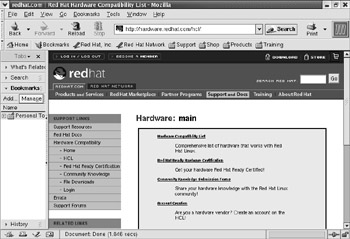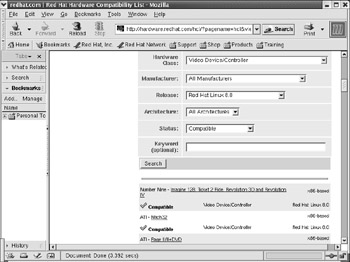Finding Compatible Hardware
On its website, Red Hat includes the latest available information on compatible hardware. Visit the hardware compatibility section of its site, currently available at http://hardware.redhat.com/hcl , as shown in Figure 2.4. Linux-compatible hardware is often organized in what is known as a Hardware Compatibility List (HCL).

Figure 2.4: Red Hat Hardware Compatibility List
Red Hat has tested hardware on a number of different PCs. However, the company also relies on the work of other Linux developers. Red Hat classifies hardware in one of the four categories described in Table 2.2.
| Category | Description |
|---|---|
| Certified | Hardware that has been officially tested by Red Hat through its official certification program, and is known to work with Linux. |
| Compatible | Hardware that has been reviewed by Red Hat personnel, outside the official certification program. |
| Community knowledge | Hardware that has been found by others to be compatible with Linux. While Red Hat may include drivers for such hardware as part of the installation CDs, it is not supported by Red Hat, Inc. |
| Not supported | Hardware that has been officially tested by Red Hat through its official certification program, and is known to not work with Linux. |
Examples of each category of hardware are discussed in the following sections.
Certified Hardware
Certified hardware has been officially tested by Red Hat Linux. Generally , you ll find entire systems, such as IBM branded servers, listed as Red Hat “certified hardware, but not single components . There are exceptions.
On the Red Hat HCL web page, you can click the Hardware Compatibility List link to navigate to a search engine for the Red Hat HCL. It s a straightforward search engine. Once you ve found hardware, you can find Red Hat s review of the component. For example, Figure 2.5 shows Red Hat s review of a network card from D-Link.

Figure 2.5: A Red Hat review of a network card
From this web page, you can see that the D-Link DFE-550 TX network card is certified using the sundance.o driver, which is available on the Red Hat Linux installation CD. If you re installing Linux over a network, you can enable the network card through the drvnet.img installation driver floppy, and it s very easy to install. In other words, you can install Red Hat Linux through this network card. You just need to make your computer read the driver disk, as described in Chapter 03 . Finally, note that this card was tested for Red Hat Linux 7.2. While this network card should work in later versions of Red Hat Linux, there is no guarantee.
Compatible Hardware
There is a subtle difference between certified and compatible hardware. Certified hardware generally consists of entire systems; compatible hardware includes individual components such as CPUs, hard drives , graphics adapters, and network cards. It s difficult to test every possible combination of components; unknown interactions can affect compatibility with any operating system.
Red Hat provides limited support to licensed users of Red Hat Linux for compatible hardware. It s easy to find a list of compatible hardware on the Red Hat HCL. Navigate to http://hardware.redhat.com/hcl , and under the support links, click HCL. At the bottom of the page, you ll see four tabs that can help you search through the Red Hat HCL.
I ve performed an Advanced Search for Video Devices that are known to be compatible with Red Hat 8.0; the results are shown in Figure 2.6.

Figure 2.6: Compatible video hardware
| Note | Web links may change by the time you read this book. If the link does not work, you ll have to use your own insight on the Internet to find the data that you need. In this case, I believe that Red Hat will always maintain an HCL, even if it s just up to Red Hat Linux 9. You should be able to find it in a support area of the site. |
Questionable Hardware
There are several categories of hardware where Linux support is less than ideal. Yet Linux developers have made progress in a number of areas. For example, it is no longer necessary to avoid all Winmodems. If you have questions about your hardware, a good place to start is the Hardware Compatibility HOWTO of the Linux Documentation Project, currently available at www.tldp.org/HOWTO/Hardware-HOWTO .
We ve listed several different categories of questionable hardware, along with resources that can help. If you can t find a driver for some component on your PC, look through the associated websites . An enterprising Linux developer may have the driver or solution for you.
| Tip | When you look for drivers, you may not need a perfect match. For example, you may be able to configure a video card using an older driver from the same manufacturer. Cameras Digital camera manufacturers generally use proprietary programs and interfaces. Despite these limits, the gPhoto developers have developed software that works with hundreds of digital cameras (see www.gphoto.net ). FireWire/iLink/IEEE 1394 FireWire and iLink are tradenames for the IEEE 1394 standard. It supports high-speed data transfer for external devices such as hard disks and video cameras. While kernel support for these devices is still experimental, help is available through www.linux1394.org . You may need to recompile your kernel (as discussed in Chapter 12 ) to enable IEEE 1394 support. Graphics cards Red Hat Linux works fine with almost all graphics cards, at least in VESA (Video Electronics Standards Association) mode, as described in Chapter 03 . But developers are improving drivers all the time. Assuming you use the default Red Hat Linux XFree86 Server, you may be able to find a driver update for your card through the XFree86 project at www.xfree86.org . Laptops Red Hat Linux works fine on most laptop computers. However, there are risks, because laptop manufacturers use a considerable amount of proprietary software. The Linux on Laptops web page at www.linux-laptop.net offers the experience of a number of users on different laptop computers. The Linux-Mobile-Guide provides detailed information on configuring laptop computers and other mobile devices at http://tuxmobil.org/howtos.html . Network cards Red Hat Linux works well with most standard network cards. But as network speeds increase, new network cards are under development; you may not find the latest driver for various Gigabit or 10 Gigabit Ethernet network card on the Red Hat Linux 9 CDs. Development work on the latest Linux network card drivers is sponsored by Scyld Computing, at www.scyld.com/network . Printers The so-called Winprinter can be as difficult to configure as the Winmodem, and new printers with more features are released at an astonishing rate. The developers at www.linuxprinting.org have done astonishing work developing new print drivers and configuration files. Scanners The Scanner Access Now Easy (SANE) home page provides tips and tricks for configuring regular and USB scanners for Linux. Currently, the home page for SANE development is at www.mostang.com/sane . Sound cards Sound cards can be difficult to configure in Linux. For example, some cards need multiple DMA channels; others can be configured to emulate one of the Sound Blaster cards. The latest information in Linux sound card support is available from the Advanced Linux Sound Architecture (ALSA) project at www.alsa-project.org . USB While Red Hat Linux can detect the basic USB keyboard and mouse during the installation process, Linux support for USB devices is currently less than ideal. But as PCs move toward converting external devices to USB and IEEE 1394 standards, Linux developers will be creating new drivers for every type of external hardware. As of this writing, support for IEEE 1394 and USB 2.0 standard high-speed equipment is still experimental. The latest information on Linux support for USB is available from the Linux USB Project at www.linux-usb.org . Winmodems As described earlier, Winmodems depend on Microsoft Windows driver libraries to support their functionality. However, the people behind the Linmodem project have developed Linux drivers that work seamlessly with many Winmodems. Many of their drivers are incorporated into Red Hat Linux 9. Many Winmodems are now detected automatically through the Linux plug-and-play system. But not all Winmodems work in Linux. For the latest status, see www.linmodems.org . |
Community Knowledge Hardware
The Linux operating system is based on a collective effort of developers from around the world. People in the Linux community have organized themselves into a number of groups. As described earlier, many of these groups are dedicated to creating and updating drivers for specific types of hardware. Their progress is documented at their websites and in mailing lists.
When you want the latest community knowledge about Linux hardware, there are four ways to direct your research. The Linux Hardware HOWTO provides an overall view of Linux hardware compatibility. However, it may not include the latest hardware information. More data is available at the websites for many hardware-specific Linux support groups, as described in the previous section. Many of these groups have open mailing lists, where developers exchange information on their latest work. Finally, users ask questions about hardware all the time on the Internet newsgroups. A searchable newsgroup database is available at http://groups.google.com .
| Note | Before asking a question on a mailing list or newsgroup, do your research first. Many Linux developers have jobs and don t have time to give you answers that can already be found in documentation, such as the LDP HOWTOs at www.tldp.org . In fact, many will show their annoyance if you waste their time. Before you ask a question on a newsgroup or mailing list, check the documentation available on the subject. Search the newsgroups or mailing list database to see if your question has been answered before. |
EAN: 2147483647
Pages: 220